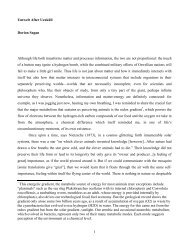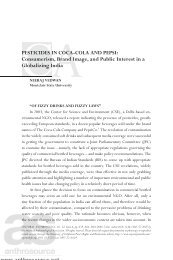The Human is More than Human - Cultural Anthropology
The Human is More than Human - Cultural Anthropology
The Human is More than Human - Cultural Anthropology
You also want an ePaper? Increase the reach of your titles
YUMPU automatically turns print PDFs into web optimized ePapers that Google loves.
of the return of the ghost of what was excluded, in th<strong>is</strong> case all the systems, living and<br />
nonliving, which make our kind possible.<br />
But I think there <strong>is</strong> another reason, more specific to anthropology, for why “the<br />
nonhuman” <strong>is</strong> pressing. <strong>The</strong>re are twice as many people on the planet today as when I<br />
was born. Th<strong>is</strong> <strong>is</strong> unsustainable. At th<strong>is</strong> rate there will be 6.5 trillion of us by the year<br />
2525—and 13.312 quadrillion by the year 3000, just around the corner in geological time.<br />
Nicholas of Cusa said the Universe <strong>is</strong> a sphere whose center <strong>is</strong> everywhere and<br />
circumference <strong>is</strong> nowhere. I don’t know about you, but that sounds about right. We love<br />
to think we are special but the h<strong>is</strong>tory of science suggests otherw<strong>is</strong>e. Now the anthropos,<br />
the human itself, <strong>is</strong> coming under pressure.<br />
Imagine an alien penetrated the roof of th<strong>is</strong> building, materializing from a<br />
scintillating beam of blue to train a cell gun on you. He, she, or it pulls the trigger.<br />
“You” begin to dematerialize. <strong>The</strong> beam annihilates every human cell in your body.<br />
Still, your form, like the recognizable smile of the Cheshire Cat, would pers<strong>is</strong>t:<br />
What would remain would be a ghostly image, the skin outlined by a<br />
shimmer of bacteria, fungi, round worms, pinworms and various other<br />
microbial inhabitants. <strong>The</strong> gut would appear as a densely packed tube of<br />
anaerobic and aerobic bacteria, yeasts, and other microorgan<strong>is</strong>ms. Could<br />
one look in more detail, viruses of hundreds of kinds would be apparent<br />
throughout all t<strong>is</strong>sues. We are far from unique. Any animal or plant<br />
would prove to be a similar seething zoo of microbes. (Folsome 1985)<br />
Life deals in such mixed cultures. It has been working with crowds for billions of years.<br />
Most of the DNA of the estimated 100 quadrillion cells in our bodies <strong>is</strong> not “ours,” but<br />
belongs to cohabiting bacteria.<br />
Great fleas have little fleas upon their backs to bite 'ʹem,<br />
And little fleas have lesser fleas, and so ad infinitum.<br />
And the great fleas themselves, in turn, have greater fleas to go on;<br />
While these again have greater still, and greater still, and so on.<br />
—Augustus de Morgan, after Jona<strong>than</strong> Swift<br />
Hypersex and Frenemies<br />
Ten percent of our dry weight <strong>is</strong> bacteria, but there are ten of “their” cells in our body<br />
for every one of “ours,” and we cannot make vitamin K or B12 without them.<br />
Vernadsky thought of life as an impure, colloidal form of water. What we call “human”<br />
also impure, laced with germs. We have met the frenemy, and it <strong>is</strong> us.<br />
But before leaving th<strong>is</strong> point of the pointill<strong>is</strong>t composition that <strong>is</strong> our Being made<br />
of beings, please notice that even those cells that do not swarm in our guts, on our skin,<br />
2






